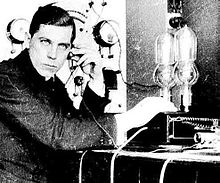Life
Early interest in technology
Tigerstedt was born in Helsinki and started to show a particular interest in all technical things at an early age. He studied his father's scientific books with great interest, and at age 11 he built a simple photographic device. At age 13, he began experimenting with other technical devices and machines, and he built his own version of an electric motor and electrical batteries. After a falling out with his father, he left home at the age of 15, supporting himself by working as a handyman and technician in mechanical workshops and shipyards in Helsinki. He later worked as a technician in the telephone industry, which was rapidly becoming a major business in Helsinki at that time.
Studies in Germany
In 1908, Tigerstedt moved to Germany to continue his studies. He completed his high school education and began studies in electrical engineering at the Friedrichs Polytechnikum [de] in Köthen. After completing his studies there in 1911, he moved back to Finland with his fiancée Marjatta Nybom, whom he had met and fallen in love with while in Köthen. She had been studying the violin in Switzerland and met Tigerstedt through her brother Albert Nybom, who was also studying in Köthen and was a classmate of Tigerstedt. However, the engagement between Tigerstedt and Marjatta Nybom was broken off in 1912.
Sound-on-film prototype
After returning to Finland, he continued his experiments and succeeded in building a prototype of sound-on-film technology ("talking movies"). Tigerstedt then returned to Germany in 1913 and founded a company with the Swedish merchant Axel Wahlstedt and the Swedish engineer Hugo Swartling [sv]. This was the first in a series of unsuccessful business ventures. Although Tigerstedt was able to complete his work with the sound-on-film technology, the partners' laboratory was eventually confiscated due to unpaid rent. They managed to reclaim their laboratory, but it was then destroyed in a fire. The cooperation between Wahlstedt and Tigerstedt became strained and in January 1914 they dissolved their company. After breaking off their commercial partnership, Wahlstedt returned to Sweden, while Tigerstedt stayed behind in Berlin, more or less broke.
Demonstration of sound-on-film
Tigerstedt continued working on his sound-on-film technology and made progress in solving a major technical problem, that of how to amplify film audio sufficiently to fill a large theatre or hall. He did this by making major improvements to the vacuum tube design of Lee de Forest, increasing the amplification capacity substantially. In February–March 1914, Tigerstedt demonstrated his sound-on-film technology to a small group of scientists, using his own film Word and Picture.
1914–1917
After being expelled from Germany in July 1914, Tigerstedt returned to Finland, but he moved to Sweden a few months later and then to Denmark in 1915. After another unsuccessful business venture, Tigerstedt once more returned to Finland. In 1917, he moved back to Denmark and founded yet another company, which was then sold. After that, he participated in the founding of the Norwegian company A/S Anod, in which he held a 45% stake.
Finnish Civil War of 1918
As a Finnish citizen, Tigerstedt was called back to take part in the Finnish civil war of 1918, and on 14 February 1918 he was on his way back to Finland. After the cessation of hostilities, he participated in the victory parade on 16 May 1918, but then returned to Denmark, where he married Ingrid Lignell in 1919. Their son Carl Axel Waldemar was born in 1921. However, their marriage soon began to deteriorate, and they separated not long after the birth of their son.
Loss of German patents
During World War I, Germany invalidated all of Tigerstedt's patents. After the war, he received compensation from the German government, but the sum quickly became worthless due to the hyperinflation in Germany during 1921 to 1923. In 1922, Tigerstedt moved his laboratory to Finland and founded a new company called "Tigerstedts patenter", which however also failed.
Move to the United States
In 1923, Tigerstedt moved to the United States where he founded his last company, the Tiger Manufacturing Co., to produce small radio receivers and cryptographic devices. The Mexican government purchased two of the cryptographic devices, and the radio receivers also sold relatively well. Tigerstedt had the opportunity to meet with the great American inventor Thomas Alva Edison, who wrote a letter of recommendation for Tigerstedt to the director of the Department of Commerce.
Death
When it finally seemed that Tigerstedt was on the verge of commercial success, he was involved in an ultimately fatal car accident on April 20, 1924, when another car unexpectedly turned in front of the car Tigerstedt was travelling in. There were persistent rumours that a competitor had arranged for the accident, but there was never any proof of this.
Exactly one year later, on April 20, 1925, he succumbed to tuberculosis at the New York Fifth Avenue Hospital, possibly due to side effects from his injuries in the car accident. He wrote his last letter to his brother Göran, in which he described the state of his company, explained the structure of a new membrane that he was developing, and stated that he was about to undergo a kidney operation due to the spreading tuberculosis. Unfortunately, medical science was not advanced enough to be able to save his life. After his death, his brother travelled to America and brought his ashes home for burial in Helsinki. As with many inventors, Tigerstedt's inventions were never fully appreciated during his own lifetime. He is buried at the Hietaniemi Cemetery owned by the Lutheran Church of Finland.
